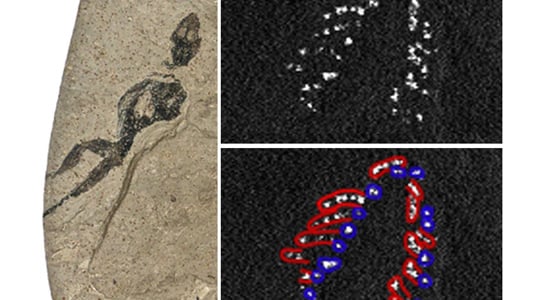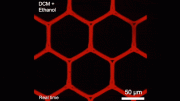
When researchers shone x-rays of certain wavelengths on what was thought to be merely a 50-million-year-old fossil of lizard skin (left), they discovered spots with high concentrations of phosphorus (dots, upper right) that they interpret as the chemical vestiges of teeth (teeth of separate jaws are outlined in blue and red, lower right). Credit: Edwards et al., Applied Physics A: Materials Science & Processing (2012)
Soft tissues, like skin and feathers, aren’t usually part of the fossil record, but a new technique has found a way to bring some of them back into the record. The technique was used to resurrect the teeth and recognize the carcass of a 50-million-year-old fossil of a lizard, long thought to be merely preserved remnants of skin shed from the reptile.
The scientists published their findings in the journal Applied Physics A: Materials Science & Processing¹. The lizard fossil was discovered in the 1980s and is one of only two known examples of reptile skin unearthed from the Green River Formation of the western USA, best known for its fish fossils. Soft tissues are very rare in the fossil record, being preserved only in unusual environmental circumstances.
The skin makes it easy to see individual scales, but the rock doesn’t include any other visible remains of bones or other hard tissue. This led the scientists to believe that the skin had been shed by a living creature and then preserved.
To learn more, the researchers used X-ray analysis, dubbed synchrotron rapid scanning X-ray fluorescence. Intense X-rays produced by this new caused particular elements or compounds to fluoresce, revealing previously unrecognized chemical remnants that are invisible to the naked eye. When the fossils were illuminated with X-rays that cause sulfur and copper to fluoresce, the skin remnants showed up in remarkable detail. They were even able to pinpoint the chemical remains of teeth.
The fossil’s state of preservation reveals a lot about the environmental conditions where the carcass ended up. The researchers believe that the carcass was probably washed into the lake soon after it died, where there was little or no oxygen, allowing the skin to be preserved while the acidic water dissolved the creature’s bones.
This X-ray technique will allow paleontologists a new way of studying extinct animals and the conditions in which they lived and died. This technique was previously used to reveal the chemical residues of pigments in feathers, providing scientists with insight into the color patterns of ancient birds. It also allows the opportunity to discern soft tissues that are only rarely preserved, like the pigment-filled retinas of eyes, ink sacs of ancient quid, and other tissues like muscles.
Reference: “Mapping prehistoric ghosts in the synchrotron” by N. P. Edwards, R. A. Wogelius, U. Bergmann, P. Larson, W. I. Sellers and P. L. Manning, 11 December 2012, Applied Physics A.
DOI: 10.1007/s00339-012-7484-3









Be the first to comment on "X-Rays Reveal More of Fossil Record"